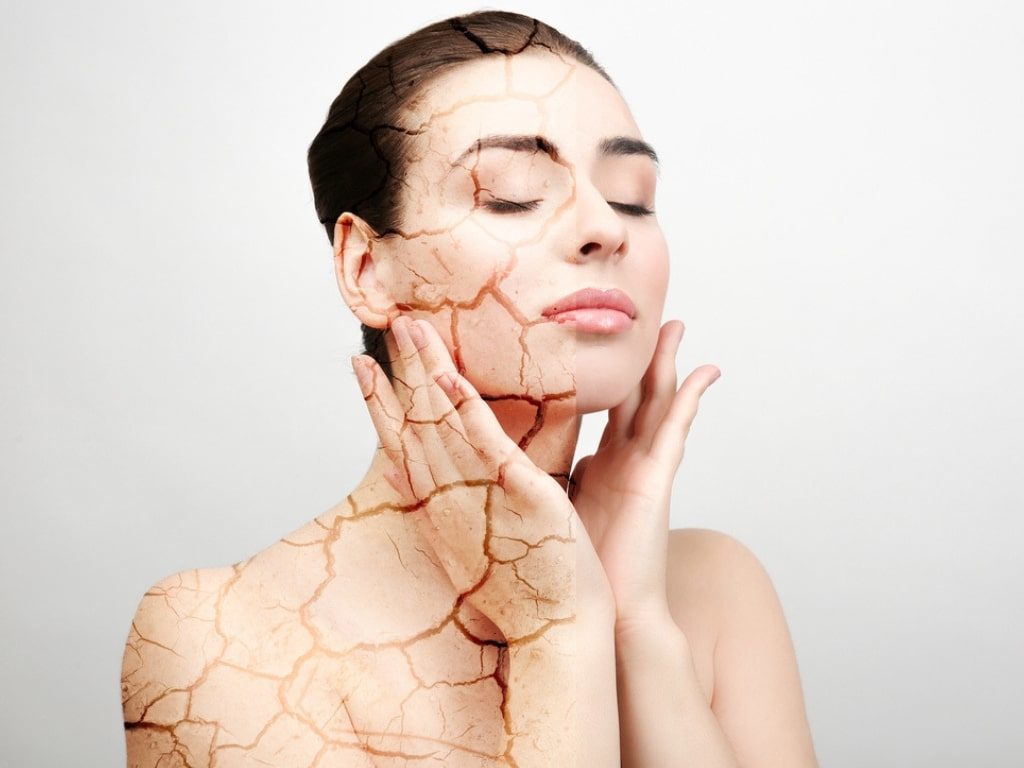Distinctive features of dry skin? It’s dull, rough to the touch and so thin that the capillaries can be seen through it. After cleansing, dry skin feels tight, but the most worryingly, it ages faster than normal or oily skin. Why does some peoples’ skin have the tendency to dryness? What are the guidelines for treating dry skin, and what are the biggest mistakes that dry skin owners may make?

What Causes Dry Skin?
Dry skin is the skin that produces less sebum than it actually needs to stay healthy. The consequences of this state are lipid shortages – fat compounds essential for retaining and locking moisture inside the skin – as well as lack of adequate protection from the external aggressors. When the protective lipid coating is damaged, the water escapes from skin at an alarming rate.
Interestingly, dry skin is rarely an inborn condition. The most common causes of dry skin are the overexposition to external aggressors (cold/dry/hot air, UV rays), following a wrong skin routine or taking some medications (applies mainly to diuretics responsible for balancing the blood pressure, hence changing the water balance in skin). This skin condition may be also one of the climacterium signs – a period in human life when the activity of oily glands decreases, and when the hydro-lipid coat is less effective in protecting the skin from losing water.
Obviously, it also happens that dry skin is genetic – typical of people with fair complexion. Lastly, this skin condition may result from underlying medical conditions or be triggered by hormones, especially during pregnancy and menopause.
Types of Dry Skin
There are two types of division. According to one of them, we distinguish dry skin, extremely dry skin and dry/sensitive skin. Dry skin feels tight and rough, whereas the extremely dry skin is almost parched, itches and flakes. The sensitive type of dry skin is additionally characterized by having hyper-reactive sensory nerves fibres in epidermis, thus so many ingredients may leave it irritated.
Another division distinguishes lipid-deprived and dehydrated skin. Whereas the former is the consequence of reduced amount of sebum, the roots of the former lie both in sweat secretion disorders and the lack of natural moisturizing agents in skin.
How To Care for Dry Skin
Moisturizers and lipid-rich creams are two essential skincare products. A moisturizing cream makes up for the insufficient number of moisturizing agents in the skin. This product delivers and retains water inside the skin. Lipid-rich creams, as the name speaks for itself, are responsible for replenishing skin with lipids to prevent water loss.
Morning beauty routine of a dry skin owner should include a moisturizer dedicated for dry skin. It delivers water to skin and shields it from the dehydrating effect of the sunlight (SPF 15). Night cream for dry skin should handle the lipid issue, repair and nourish skin. The best effects are delivered by rich creams, formulated with ceramides, plant oils, urea and emollients.
It must be realized that dry skin shouldn’t be exposed to alcohol-based cosmetics because they contribute to dryness, often leaving skin irritated. The most preferable products are cleansing milks, emulsions and toners destined for dry skin, obviously. Using micellar cleansers shouldn’t cause any adverse effects either. Once in a week, it’s suggested doing some exfoliation treatment, only with enzymatic peels, that should be followed with moisturizing or nourishing facial masks.
Most Common Bad Dry Skin Care Habits
There are many skincare products and treatments that make things worse, causing even more damage, and therefore they must be completely eliminated from a skin routine. Here they are:
- mechanical peels (their interference in skin is too strong)
- washing face with chlorinated water (it dehydrates and irritates skin)
- washing face with soap (it dehydrates and irritates skin, as well as strips it off sebum that the skin already produces in insufficient amounts)
- rubbing skin while drying it with a towel (it deprives skin of sebum)
- using thermal water (it often contributes to dryness)



Leave a Reply